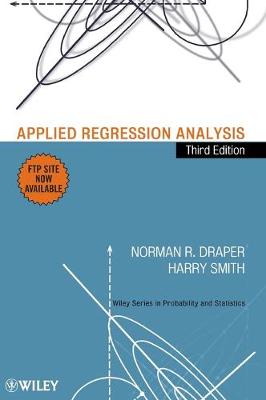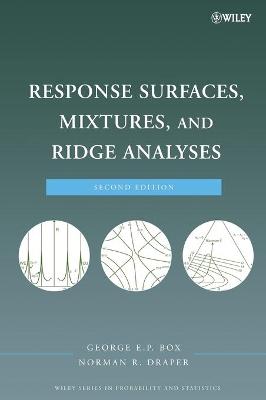Wiley Series in Probability and Statistics
3 primary works • 4 total works
Book 326
For analysts, researchers, and students in university, industrial, and government courses on regression, this text is an excellent introduction to the subject and an efficient means of learning how to use a valuable analytical tool. It will also prove an invaluable reference resource for applied scientists and statisticians.
Book 649
Response Surfaces, Mixtures and Ridge Analyses 2e
by George E. P. Box and Norman R. Draper
This unique, fully developed coverage of ridge analysis-a technique for exploring quadratic response surfaces including surfaces in the space of mixture ingredients and/or subject to linear restrictions-includes MINITAB(r) routines for performing the calculations for any number of dimensions. Many additional figures are included in the new edition, and new exercises (many based on data from published papers) offer insight into the methods used. The exercises and their solutions provide a variety of supplementary examples of response surface use, forming an extremely important component of the text. Response Surfaces, Mixtures, and Ridge Analyses, Second Edition presents material in a logical and understandable arrangement and includes six new chapters covering an up-to-date presentation of standard ridge analysis (without restrictions); design and analysis of mixtures experiments; ridge analysis methods when there are linear restrictions in the experimental space including the mixtures experiments case, with or without further linear restrictions; and canonical reduction of second-order response surfaces in the foregoing general case.
Additional features in the new edition include:* New exercises with worked answers added throughout* An extensive revision of Chapter 5: Blocking and Fractionating 2k Designs* Additional discussion on the projection of two-level designs into lower dimensional spaces This is an ideal reference for researchers as well as a primary text for Response Surface Methodology graduate-level courses and a supplementary text for Design of Experiments courses at the upper-undergraduate and beginning-graduate levels.
Book 700
This set contains:
Statistical Control by Monitoring and Adjustment, Second Edition (978-0-470-14832-7)
Recent research has shown that monitoring techniques alone are inadequate for modern Statistical Process Control (SPC), and there exists a need for these techniques to be augmented by methods that indicate when occasional process adjustment is necessary. Statistical Control by Monitoring and Adjustment, Second Edition presents the relationship among these concepts and elementary ideas from Engineering Process Control (EPC), demonstrating how the powerful synergistic association between SPC and EPC can solve numerous problems that are frequently encountered in process monitoring and adjustment.
The book begins with a discussion of SPC as it was originally conceived by Dr. Walter A. Shewhart and Dr. W. Edwards Deming. Subsequent chapters outline the basics of the new integration of SPC and EPC, which is not available in other related books. Thorough coverage of time series analysis for forecasting, process dynamics, and non-stationary models is also provided, and these sections have been carefully written so as to require only an elementary understanding of mathematics. Extensive graphical explanations and computational tables accompany the numerous examples that are provided throughout each chapter, and a helpful selection of problems and solutions further facilitates understanding.
Statistical Control by Monitoring and Adjustment, Second Edition is an excellent book for courses on applied statistics and industrial engineering at the upper-undergraduate and graduate levels. It also serves as a valuable reference for statisticians and quality control practitioners working in industry.
Statistics for Experimenters: Design, Innovation, and Discovery, Second Edition (978-0-471-71813-0)
This fresh approach to statistics focuses on applications in the physical, engineering, biological, and social sciences. From the beginning its source of ideas is the scientific method itself and the need of the investigator to make his or her research as effective as possible through proper choice and conduct of experiments and appropriate analysis of data. After a problem is stated, appropriate statistical methods of design and analysis are discussed. And frequently, examples are presented for which standard mathematical assumptions are wrong, thus forcing the reader's attention onto the essential precautions necessary in the conduct of the experiment to ensure valid conclusions. Statistical practitioners themselves, the authors provide scientists and engineers with a lucid introduction to the basic statistical methods needed for research.
George Box has a unique ability to explain complex ideas simply and eloquently. This revised edition of his masterworks since 1982 clearly demonstrates the range of his wit and intellect. These fascinating readings represent the cornerstones in the theory and application of process improvement, product design, and process control. Readers will gain valuable insights into the fundamentals and philosophy of scientific method using statistics and how it can drive creativity and discovery.
The book is divided into five key parts:
* Part A, Some Thoughts on Quality Improvement, concerns the democratization of the scientific method and, in such papers as "When Murphy Speaks--Listen," advises managers to view operation of their processes as ongoing opportunities for improvement.
* Part B, Design of Experiments for Process Improvement, illustrates the enormous advantages offered by experimental design in the pursuit of better products and processes.
* Part C, Sequential Investigation and Discovery, shows how sequential assembly of designs allows the experimenter to match the difficulty of the problem with the effort needed to solve it.
* Part D, Control, describes application of feedback control in the Statistical Process Control (SPC) environment. A simple graphical technique using Box-Jenkins charts is set forth to appropriately adjust processes to target.
* Part E, Variance Reduction and Robustness, demonstrates how the existence of more than one source of variation may be used to achieve products robust to the environment in which they must function and emphasizes the importance of error transmission and data transformation in producing robust assemblies.
A Foreword by Dr. J. Stuart Hunter allows readers to gain insight into the workings of a remarkable mind and explains how these ideas can greatly catalyze their efforts in process improvement.



